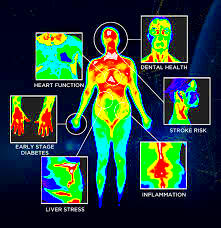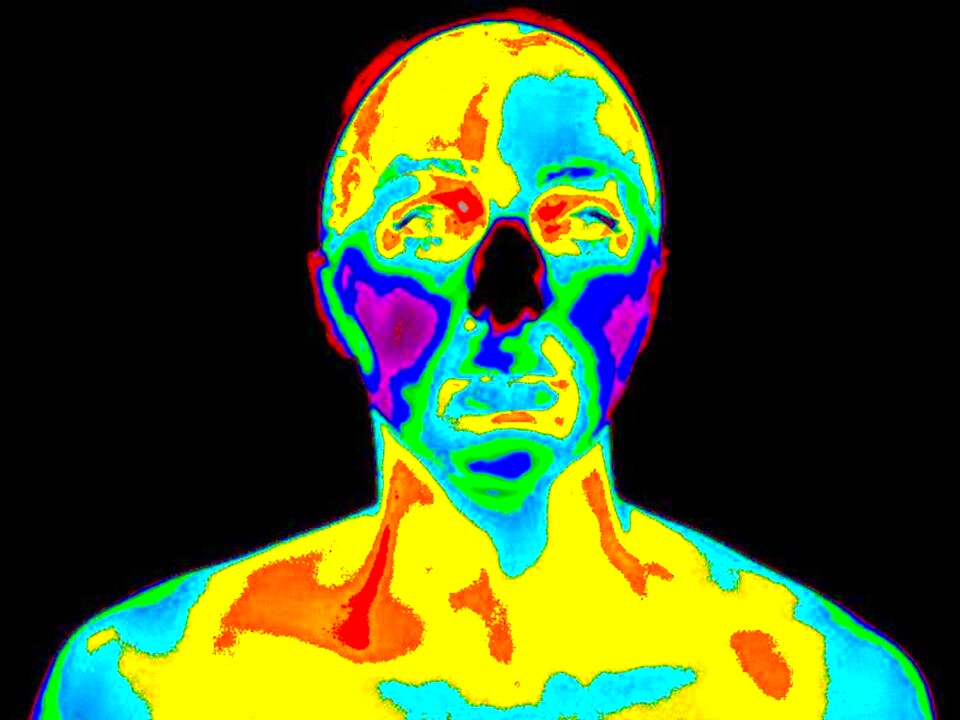Thermal imaging is a fascinating technology that captures heat patterns instead of visible light, allowing us to "see" temperature differences. This tool is widely used in various fields, but when applied to the human body, it opens up incredible possibilities for understanding health and physiology. Whether you're new to this technology or just curious, this guide will help you explore how thermal imaging works and what it can reveal about the human body.
What Thermal Imaging Reveals About the Human Body

Thermal imaging provides a unique way to observe the human body by capturing heat signatures emitted by the skin. These signatures can reveal important insights into bodily functions and potential health issues. Here’s what thermal imaging can show:
- Blood flow patterns: Abnormal heat patterns might indicate circulation issues or inflammation.
- Injuries and infections: Warmer areas often highlight inflammation or infections, while cooler areas may signal poor blood supply.
- Stress and emotional states: Changes in facial or hand temperature can indicate stress or anxiety.
By analyzing these heat patterns, medical professionals can often detect early signs of conditions like arthritis, nerve damage, or vascular diseases. Since the process is non-invasive and painless, it’s a great option for preliminary screenings.
Also Read This: Comparing Fubo TV and YouTube TV to Determine the Superior Streaming Service
The Science Behind Thermal Imaging Technology

Thermal imaging operates on the principle that all objects, including the human body, emit infrared radiation based on their temperature. This radiation is invisible to the naked eye but can be captured using specialized cameras equipped with infrared sensors.
The process involves:
| Step | Details |
|---|---|
| 1. Infrared Detection | Infrared cameras detect heat emitted by objects and convert it into an electrical signal. |
| 2. Data Processing | The signal is processed to create a visual image, typically using colors to represent temperature differences. |
| 3. Temperature Mapping | Colors like red and orange represent warmer areas, while blue and green show cooler zones. |
Modern thermal cameras are highly sensitive, capable of detecting minute temperature changes, making them incredibly useful for medical and scientific applications.
Also Read This: Finding Full Classic Movies on YouTube Including A Bug’s Life
How Thermal Imaging Detects Temperature Variations
Thermal imaging detects temperature variations by capturing infrared radiation emitted from the surface of objects. All warm bodies, including the human body, release heat in the form of infrared radiation, which is invisible to the naked eye. Thermal cameras are designed to detect this radiation and convert it into a visual image, showing temperature differences as color variations.
Here's how the detection process works:
- Infrared Sensors: The thermal camera uses sensors to detect infrared radiation emitted by the body. The sensors are extremely sensitive, picking up even slight temperature differences.
- Heat Mapping: The radiation data is transformed into a thermal image, where colors represent different temperatures. Warmer areas might appear in red, orange, or yellow, while cooler areas show as blue or green.
- Temperature Calibration: The camera is calibrated to ensure accurate temperature readings. It adjusts based on environmental factors, such as ambient temperature and distance from the subject.
By capturing these variations, thermal imaging allows doctors and researchers to visually track and monitor changes in body temperature, helping them detect conditions that would be difficult to see with the naked eye.
Also Read This: Effective Ways to Block YouTube on Fire Tablet for Screen Time Management
Applications of Thermal Imaging in Healthcare
Thermal imaging has become a valuable tool in healthcare, offering a non-invasive and efficient way to detect and monitor a variety of conditions. From diagnosing injuries to assessing blood circulation, the uses are vast and varied. Here are some common applications of thermal imaging in healthcare:
- Injury Detection: Thermal imaging helps identify areas of inflammation or muscle strain by highlighting temperature differences caused by blood flow and tissue damage.
- Detection of Infections: Heat patterns can reveal areas of infection or inflammation in the body, which are typically warmer than surrounding tissue.
- Monitoring Circulatory Health: It is often used to monitor blood circulation and detect vascular issues, like poor blood flow or blockages in arteries.
- Breast Cancer Screening: Thermal imaging can be used as a complementary tool to detect unusual heat patterns associated with abnormal growths in breast tissue.
Due to its ability to provide early detection and monitor the progression of various health conditions, thermal imaging is increasingly integrated into routine medical checkups and diagnostic procedures.
Also Read This: Exploring Top Tech Schools That Offer Quality Education in the USA
Benefits of Using Thermal Imaging for Diagnosis
Thermal imaging offers numerous benefits, especially in the field of medical diagnostics. This innovative technology has revolutionized the way healthcare professionals detect, diagnose, and monitor a variety of conditions. Below are some key advantages of using thermal imaging:
- Non-invasive: Thermal imaging is a completely non-invasive procedure, meaning no needles, injections, or surgeries are required. It simply involves capturing heat signatures from the surface of the body.
- Painless: Since there is no contact with the body, thermal imaging is a painless process that is comfortable for patients.
- Early Detection: By identifying abnormal temperature patterns early, thermal imaging can help detect conditions such as inflammation, infections, or cancer at an early stage, often before physical symptoms appear.
- Real-time Results: Thermal images can be captured and analyzed instantly, providing healthcare professionals with real-time data that can be crucial for making quick decisions.
- Complementary Tool: Thermal imaging is an excellent complement to other diagnostic tools, such as X-rays and MRIs, offering additional insights and helping healthcare providers form a complete picture of a patient's health.
Given these benefits, thermal imaging is increasingly becoming an integral part of medical diagnostics, providing a safe, effective, and efficient way to monitor and treat patients.
Also Read This: Alibaba to Amazon Shipping: Streamlining Your E-commerce Pipeline
Common Misconceptions About Thermal Imaging
Although thermal imaging has become more popular, several misconceptions about the technology still persist. These misunderstandings can lead to confusion about its capabilities and limitations. Let’s clear up some of the most common myths:
- Thermal Imaging Detects Only Heat: While thermal cameras do capture temperature variations, they don’t just show heat. They reveal differences in temperature, which can be cooler or warmer than surrounding areas. It’s not about detecting heat, but rather identifying temperature patterns that may indicate underlying issues.
- Thermal Imaging Can Diagnose Diseases: Thermal imaging is a useful tool for detecting signs of possible medical conditions, but it is not a diagnostic tool on its own. It provides valuable information that must be interpreted alongside other medical tests and procedures.
- Thermal Imaging is Only for Healthcare: While thermal imaging has significant applications in healthcare, it is also widely used in industries like construction, security, and environmental monitoring. It’s a versatile tool for any situation requiring temperature analysis.
- Thermal Imaging is Inaccurate: Modern thermal cameras are highly accurate and sensitive. However, the quality of the results depends on how well the camera is calibrated and how carefully the procedure is conducted.
- Thermal Imaging Requires Special Conditions: Thermal imaging can be used in most environments, although extremely hot or cold conditions may affect accuracy. Generally, it works in everyday settings without needing any special preparations.
By understanding these misconceptions, you can better appreciate how thermal imaging works and its real capabilities in various fields.
Also Read This: How to Stream Rumble on Your TV
Frequently Asked Questions About Thermal Imaging
Thermal imaging is still relatively new to some people, which raises many questions about its functionality and uses. Here are some of the most frequently asked questions about thermal imaging technology:
- How accurate is thermal imaging?
Thermal cameras are highly accurate, with some devices capable of detecting temperature variations as small as 0.1°C. The accuracy can depend on the quality of the camera and the environment. - Can thermal imaging detect cancer?
While thermal imaging can highlight unusual temperature patterns that may suggest abnormal growths, it cannot definitively diagnose cancer. It is used as a complementary tool in conjunction with other diagnostic methods. - Is thermal imaging safe?
Yes, thermal imaging is completely safe. It doesn’t involve radiation or any harmful procedures. It’s a non-invasive, painless way to gather important health information. - Can thermal cameras see through clothes?
Thermal imaging only captures the surface temperature of objects. It can detect temperature differences on the surface of the skin but cannot "see through" clothing or other materials. - How long does a thermal imaging scan take?
Thermal imaging scans are quick and usually take just a few minutes to complete, depending on the area being examined and the camera used.
These FAQs highlight the basic aspects of thermal imaging, addressing both its capabilities and limitations, and providing clarity on how this technology can be used in healthcare and beyond.
Conclusion on Thermal Imaging and Its Role
Thermal imaging has proven to be an invaluable tool in various fields, especially in healthcare. By detecting temperature variations, it provides insight into the body's internal processes, helping doctors identify potential health issues early. From monitoring inflammation and infections to assessing blood circulation, thermal imaging offers a non-invasive and painless way to gain valuable medical data.
Despite some common misconceptions, thermal imaging is not only accurate but also versatile. It's used across many industries, not just healthcare, making it a powerful tool in both diagnostics and other practical applications like security, maintenance, and environmental monitoring.
As technology continues to advance, the role of thermal imaging will only expand, offering even more potential for early diagnosis and better patient care. With its ability to detect problems before they become visible or symptomatic, thermal imaging will remain an important part of modern healthcare and beyond.











